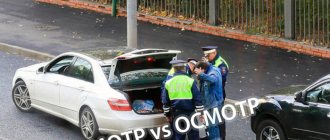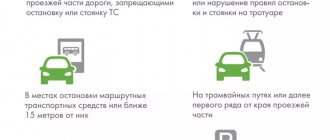Reasons for evacuation
Detention of a car by evacuation is regulated by Art. 27.13 Code of Administrative Offenses of the Russian Federation. This section is regularly updated, in 2021 it includes the following reasons why a vehicle may be detained (clause 1 of article 27.13):
- If the driver driving the car does not currently have a vehicle registration certificate.
- Known malfunction of the brake system (except for the handbrake), coupling system, steering.
- If the car is driven by a person who does not have a driver’s license or has been deprived of one.
- Driving while intoxicated (this includes alcohol and drug intoxication), as well as the driver’s refusal to undergo a medical examination.
- Leaving a car in a place where it is prohibited (signs prohibiting stopping or parking must be accompanied by a “Tow Truck Operating” sign).
- Parking at the pedestrian crossing and at a distance closer than 5 meters in front of the crossing.
- Parking on the sidewalk.
- Stop or park at public transport stops and closer than 15 meters from the stop. The exception is cases when the stop is forced or for the purpose of boarding and disembarking passengers.
- Leaving a car on the roadway, where it is an obstacle to the passage of other cars, or in a tunnel.
- Failure to comply with the rules for transporting large and dangerous goods.
- Drinking alcoholic beverages after an accident, or when stopped by a traffic police inspector, before deciding on the issue of undergoing an examination.
The following are not grounds:
- the driver does not have a license(s),
- lack of compulsory motor liability insurance policy.
Legitimate reasons for evacuation
The Code of Administrative Offenses of the Russian Federation lists all possible cases in which a car must be towed to an impound lot (Articles 27.13 and 27.12):
- If the driver does not have a registration certificate for this vehicle.
- If the driver does not have a license to drive the vehicle.
- If the car has identified malfunctions in the steering mechanism or brake system of the vehicle. (In general, a car is towed in cases where it cannot safely move on the roads on its own).
- If the driver of the vehicle is under the influence of alcohol or drugs, increased fatigue, etc.
- If the driver does not agree to undergo a medical examination to determine the degree of his sobriety. This also includes situations where, after an accident, the driver took alcohol or an alcohol-containing drug after the incident, but before the arrival of traffic police officers.
- If vehicle parking rules are violated. This also includes cases when a parked car physically interferes with the passage of other cars, reducing the dimensions of the roadway below the permissible value.
- If the rules for transporting goods that pose an increased danger, as well as oversized objects, are violated.
However, according to the law, evacuation is a procedure in which several officials take part at once. If these administrative actions are not carried out properly, then, according to the rules, the entire evacuation procedure may be considered illegal (and the vehicle owner will also be awarded compensation). We’ll talk about how realistic this picture of events is in practice below, but for now let’s touch on the algorithm of actions of evacuating employees.
Car evacuation procedure
In accordance with the traffic rules, a traffic police officer, when identifying certain violations, is obliged to give the driver the opportunity to correct them independently and immediately (for example, warn a stopped car that parking in this place is prohibited for his car). Another thing is that such an opportunity is not always present, because traffic police officers do not guard all parking lots in the city. Therefore, evacuation is most often carried out upon detection of an offense. The evacuation process must be accompanied by the following formalities:
- The presence of at least two independent witnesses is required. In fact, this is a very difficult condition to fulfill, because it cannot be other traffic police officers from the squad, nor anyone from the tow truck crew, nor other employees providing the procedure for seizing the vehicle. In this case, most often the condition is fulfilled only formally (the signatures of the witnesses are placed retroactively), but if you try to challenge the actions of the tow truck operators and file a lawsuit on the basis of the unreliability of the signatures of the witnesses, then it most likely will not be satisfied or even considered.
- The fact of evacuation must be accompanied by the drawing up of a protocol (which must be signed by both witnesses). The vehicle being towed must contain a detailed description (or even photo or video recording). This is necessary so that later it is possible to identify the time of damage to the vehicle if it occurred through the fault of the evacuating crew.
- The car must pass the typo.
Cost of towing a vehicle to an impound lot
The evacuation procedure is not a cheap thing. The cost of the procedure for removing a vehicle to a special parking lot depends on the power of its engine (the connection is quite conditional; first of all, of course, the dimensions of the transported vehicle are important):
- Cat. A, B; power - up to 80 hp — 3 thousand rubles
- Cat. IN; power - 81-250 hp, except for cargo vehicles - 5 thousand rubles.
- Cat. IN; power - from 251 hp, except for cargo vehicles - 7 thousand rubles.
- Cat. D; cargo vehicles, except oversized vehicles - 27 thousand rubles.
- Oversized vehicles - 29 thousand rubles.
Despite the fact that the fine for improper parking can be 1.5 thousand rubles, payment of a minimum of 3 thousand only for the actions of tow trucks (without taking into account storing the car in the parking lot) is really a lot. In this regard, of course, many drivers have a desire to protest the evacuation, including through the courts. But the most important thing is that they actually have the opportunity to appeal.
Restrictions and evacuation rules
Transportation of the car to the impound lot is carried out in the manner specified in paragraphs. 3-10 tbsp. 27.13 Code of Administrative Offenses of the Russian Federation. The arrest is made by an authorized person (i.e., a traffic police inspector) based on the fact of an offense. At the scene of the violation, a protocol is drawn up, which is signed by the inspector, indicating his data and position, and is also signed by the violator. The protocol must indicate:
- grounds for vehicle detention,
- date Time,
- vehicle (make, model, license plate),
- transportation service.
If the violator refuses to sign the document, this is recorded in the protocol.
When the guilty person is absent from the scene of the violation, the protocol must be drawn up in the presence of two witnesses, or on video recording. It is given to the person along with the decision to return the vehicle, after the reason for the detention has been eliminated (usually it is received at the impound lot after receiving the car).
The vehicle to be towed must be sealed during loading: all doors, incl. trunk, sealed with a special seal. The evacuation service is responsible for the safety of the vehicle during loading and storage. The parking lot must be located in a closed area, and video surveillance must be installed throughout its entire area.
It is prohibited to transport the car with passengers. The traffic police officer does not have the right to demand that passengers leave the car; in this case, he must limit himself to a fine.
Important: if the driver arrived before the tow truck started moving, the car must be returned to the owner, even if it has already been loaded and sealed (Clause 1.1 of Article 27.13 of the Code of Administrative Offenses of the Russian Federation).
Price
The cost of transportation and storage of cars is determined by the laws of the constituent entities of the Russian Federation, in accordance with clause 11 of Article 27.13 of the Code of Administrative Offenses of the Russian Federation. The person who committed the offense pays the cost of transportation (in the receipt this is called “Tow Truck Services”) and storage of the vehicle in the impound lot. Parking is paid daily, there is no hourly fee. As a general rule, the first partial day is not subject to payment. To pick up the vehicle, you will have to pay the cost of transportation and stay at the impound lot.
The cost of transportation varies depending on the type and capacity of the vehicle and can vary several times in different regions. Thus, in Moscow, transporting a passenger car will cost 8,125 rubles, and a day’s stay costs 2,090 rubles. (Order of the Department of Transport and Development of DTI Moscow dated December 29, 2016 No. 61-02-518/6). In other regions of the Russian Federation, the cost of transportation is usually several times lower.
In addition, the driver will also have to pay a fine, which varies depending on the type of offense: 500 rubles. for an incorrect stop (parking), 1000 rubles. for parking on the sidewalk, 2000 rubles. for parking on the roadway, etc.
Important: you do not need to pay the fine immediately, 60 days are allotted for this, but in the first 20 days there is a “discount” - 50% of the fine amount. After 60 days, the initial amount is doubled.
When can you challenge
In accordance with Art. 24.5 of the Code of Administrative Offenses of the Russian Federation, proceedings for an offense are terminated for the following reasons:
- there is no corpus delicti (for example, a sign prohibiting parking is hidden behind trees - accordingly, the driver is not at fault, and there is no corpus delicti);
- there is no crime event (the car was towed illegally or erroneously - no traffic rules were violated);
- actions in extreme necessity (when committing an offense, a person acted in order to save his own or someone else’s life, or in the interests of society or the state, while the damage caused is less significant than the potential danger - Article 2.7 of the Code).
If the detention of a vehicle falls under the listed conditions, the decision on the case can be appealed.
How to find out why the car was taken to the impound lot
This is very simple to do: let's say you didn't find your car in the place where you left it. Then you need to immediately call the traffic police hotline. The following questions need to be asked:
- Whether your car has been towed or stolen. Information about the seizure of a vehicle enters the traffic police database immediately after drawing up the protocol, that is, even before the car is loaded onto the trailer, that is, there cannot be any time lags or “blind spots” when the information has not yet been received. .
- As a rule, the dispatcher will immediately tell you the reason for the evacuation. It must comply with the above-mentioned Articles 27.12 and 27.13 of the Administrative Code, Federal Law No. 205-FZ, as well as regional regulations. To put it another way, the reasons for evacuation must correspond to those listed in section 1 of this article.
- Next, you should find out which impound lot your vehicle was taken to, which district traffic police department it is assigned to, as well as your full name. the traffic police officer who drew up the seizure protocol.
All this can be done by phone, or online (in accordance with traffic regulations, all seizures of vehicles must be reflected on the official Internet resources of the traffic police):
- https://xn--90adear.xn--p1ai/;
- https://avtokod.mos.ru/;
- https://transport.mos.ru/;
- https://parking.mos.ru/
Where to go when towing a car
If the car has been towed, first of all, it is necessary to pick it up so that you do not have to overpay for the duration of your stay. To find out where the vehicle was taken, you need to call the evacuation service of the given city (locality), but if there is no information about this, you can always call the single line of the Ministry of Internal Affairs, which will connect to the traffic police department:
- 102 (from mobile), 01 (from landline), 911 - from all phones (emergency calls), or find the number of the duty station of your region in this section of the website traffic police.rf/divisions/. Also, in the contacts of the branches there is always a hotline where all requests from citizens are considered.
Before leaving the scene of the accident, you need to collect evidence - in the event that the car was taken away without legal grounds. It is necessary to take photographs of signs, markings and other important landmarks. Residents of Moscow can also use the service atlas.mos.ru, where they can take screenshots of panoramas of the city and region.
Where to complain
It is necessary to appeal not the evacuation, but the decision in the case of an administrative violation - it is the basis for the detention of the car. The resolution is being challenged in accordance with Article 30.1 of the Code of Administrative Offenses of the Russian Federation, paragraph 3, according to which a citizen can file a complaint about illegal evacuation:
- to a court of general jurisdiction (district or city in small towns);
- to a higher official (the head of the traffic police inspector who drew up the protocol);
- to a higher authority (traffic police department for the city, region).
The applicant himself chooses where to appeal the act of law enforcement agencies. However, lawyers express the opinion that filing a complaint with the traffic police department makes sense only in cases where erroneous or unlawful actions of the inspector are obvious and there is direct evidence of this. When the situation is controversial or ambiguous, you should go to court - there is a greater chance of a fair hearing of the case.
Deadlines for appeal
You can challenge the evacuation order within 10 days (Article 30.3 of the Code). The period begins to run from the moment when the violator signed the protocol (if it was drawn up in his presence), or from the day when he received a letter with a copy of the document. If the violator does not receive the letter, it will be counted from the moment the letter is returned to the sender (it is stored at the post office for 30 days).
This deadline can be restored only if it was missed for valid reasons. These include: illness, absence of a citizen (for example, going on a business trip), postal failure when delivering a letter, etc. In this case, a petition to restore the deadlines, which is supported by documents, is submitted to the court along with the claim.
How to write an application to appeal a decision to tow a car
To appeal against illegal evacuation, it will be necessary to draw up a special application and submit it to the court. If possible, you should familiarize yourself with a correctly compiled sample in advance. This way you can avoid making the most common mistakes.
If possible, you should seek advice on this matter from a qualified lawyer.
Applications to appeal illegal evacuation must contain the following information:
- name of the authority where the specific application will be submitted;
- FULL NAME. the official in whose name the statement of claim is drawn up;
- FULL NAME. the individual or legal entity submitting the application of the type in question;
- the address of the applicant’s permanent location to which the response to the previously submitted application will be sent;
- all the circumstances of the case in relation to which a certain type of agreement is being assigned are indicated;
- a complete list of other information directly related to the situation under consideration;
- Full name, as well as the position of the employee who, for some reason, made an unlawful decision regarding the evacuation of the vehicle;
- a complete list of all attached documents;
- signature with transcript from the applicant;
- date of drawing up the application itself.
Sample application to appeal illegal evacuation.
There are special requirements established by law for writing an application of the type in question. It is important to comply with all of them.
It should be remembered that violation of the basic rules will lead to the return of the application and all documents for revision. It is especially important to correctly date the application. It must coincide with the date of submission of documents.
In case of discrepancies, the court office simply will not accept the document. It will be returned for revision.
At the traffic police
When contacting law enforcement agencies, there are two options - contact a higher official, or contact a higher authority. A complaint about evacuation is drawn up according to the general rules, in an official business style. It is necessary to attach copies of all available documents (decrees, receipts for payment for tow truck services, evidence, etc.).
Contents of the statement
A complaint about the evacuation of a car is drawn up according to the following principle:
- name of the service department and full name of the head (you must always indicate a specific official, it is better to indicate the main head of the department);
- Full name of the applicant, registration address, contact telephone number;
- date and number of the resolution, data of the inspector who drew up the act;
- essence of the appeal: why the resolution and evacuation were illegal, references to regulations;
- summary: “I ask you to cancel resolution No. and return the funds paid for transportation services in the amount of...”;
- date, signature, note about the consideration of the case in the absence of the applicant,
- list of applications.
Here you can .
We recommend reading: Complaint against the traffic police decision
Internet resources
In some constituent entities of the Russian Federation, it is possible to appeal the inspection decision through special Internet services. In Moscow, such complaints are accepted on the website avtokod.mos.ru/Appeals/.
To appeal the illegal towing of a car, you must select the “appeal to MADI” section and fill out the form that appears.
You can also contact MADI through the service www.mos.ru/feedback/individual/, where all fields (personal data, resolution number and essence of the request) are also filled out.
The traffic police website also provides for sending an electronic appeal, but in this way it is impossible to appeal the order of the employees, since such an appeal is considered within 30 days and is intended to resolve general issues, and 10 days are allotted for consideration of the complaint.
To court
Situations that are controversial are best resolved in court. The complaint is filed with the district court at the place of the offense - that is, where the evacuation took place.
Please note: appealing an administrative decision is not subject to state duty (Clause 5, Article 30.2 of the Code of Administrative Offenses of the Russian Federation).
The statement of claim is not regulated by the Code and is drawn up in free form:
- name of the judicial authority,
- applicant details (full name, address, contact phone number),
- title: complaint in a case of an administrative offense,
- descriptive part (details of the resolution, full name of the official, brief description of what happened),
- the plaintiff’s arguments about the unreasonableness of actions with references to laws,
- operative part (I ask the court to cancel... and collect...),
- date, signature, list of attachments.
An example of applying to court can be downloaded here.
An application to law enforcement agencies or the court can be submitted in person, immediately receiving the number of the incoming document, or sent by mail. To prevent the document from getting lost, the complaint is sent by letter with a list of attachments and a notification of delivery.
What documents to attach to the application
In the case under consideration, it will be necessary to attach to the application the maximum number of documents that disclose the case. First of all, this applies specifically to evidence of the illegality of the evacuation.
The full list of documents attached to statements of claim when filing them in court includes the following:
- notification of delivery or other confirmation of sending all necessary documents directly to the defendant party (State Traffic Safety Inspectorate);
- confirmation of payment of the state fee for consideration of this case - for certain categories of citizens payment of the fee is not required;
- documents confirming the illegality of the evacuation: photographs;
- video recordings;
- written testimony of witnesses.
It should be remembered that the documents themselves can be presented in several ways:
- independently in person - to the court office;
- through a representative - only possible with a properly executed power of attorney;
- in electronic form via the Internet.
It is important to know that some documents must be properly notarized. It is also important to familiarize yourself with the evidence requirements in advance.
For example, if there is photo and video footage from the scene of an incident, the files must be of a certain quality. All requirements for confirmations are reflected in the legislation in force in the Russian Federation.
Consideration of the appeal
In accordance with Art. 30.6 of the Code of Administrative Offenses of the Russian Federation, when appealing to a higher official or a higher authority, the complaint is considered within 10 days (clause 1). The court has different rules, where the appeal is considered within 2 months (clause 1.1 of Article 30.5).
Based on the results of the consideration, a decision is made to cancel the resolution or to leave it in force. This decision is sent to the applicant within 3 days.
Refund
When making a decision in favor of the applicant, the road inspection or the court must themselves send a copy of the documents on the return of money, but in practice this is not always done. If the proceedings are terminated, the costs of transportation and maintenance of the vehicle are paid from the local budget (clause 12 of article 27.13). The applicant must contact the Department of Finance of the region (city) with an application for a refund and attach a copy of the cancellation certificate. In the application, it is important to indicate the details where the funds will be transferred.
Refund of money and compensation for moral damages for illegal towing of a car
If you believe that your car was towed illegally, and have significant evidence of this, write an application for the return of funds to the State Property Committee or a statement of claim for the same in court.
The first option is preferable, since there is no need to strictly follow the established form: the legislator does not define a uniform document format.
However, for your application to be considered and for you to get what you want, the application must contain the following information:
- your personal data (last name, first name, patronymic, year of birth, place of residence);
- characteristics of the vehicle that allow it to be identified (model, make, external features);
- information about the state number issued to you;
- date and time of the evacuation service;
- your personal signature, which matches the one presented in the passport, and its transcript;
- date of writing the paper.
Having submitted the application to the registrar, you must receive a corresponding receipt from him. If you were unable to obtain a return of the money spent through the Civil Code, do not be upset: you can file a claim in court. This document is no longer allowed to be drawn up in free form.
Sample statement of claim for appealing illegal evacuation.
Drawing up a document is responsible and difficult for citizens who do not have relevant experience. Therefore, if you do not want to spend time and effort searching for the right solutions on your own, and then, if unsuccessful, submit documents again, it is better to immediately contact an experienced lawyer: with his help, any paper will be drawn up correctly the first time.
It will not be enough for you to submit one application both to the Civil Code and to the court; a package of the following documents should be attached to it:
- a copy of a document that allows you to identify your identity (passport, international passport or driver’s license);
- photocopies of the documents necessary to drive a car (the traffic police inspector asks you to present them when you stop);
- certificate of termination of proceedings in the case of an administrative offense, if any;
- a copy of the court order, if you have previously filed a claim there.
As practice shows, the entire process of returning money, provided that you have provided significant evidence that the evacuation service employees and/or traffic police inspectors were wrong and have correctly completed the application, takes about 8 working days, of which:
- Your application will be considered for 5 days, after which you will be sent either a notice of return of the spent funds, or a notice of refusal to satisfy the claim;
- 3 days - the period required for crediting the returned money to the bank details specified in your application.
You should not contact the Civil Code of Ukraine if you are not sure of the quality of the evidence you have collected about the illegality of your opponents’ actions; in this case, it is best to apply to the magistrate’s court with a statement of claim.
You can submit demands for the return of funds deposited into the account of the towing company (for the evacuation of the vehicle and its stay in the impound lot) and for compensation for moral damage incurred and other expenses in one statement of claim.
You can draw up the paper yourself or, if you don’t want to bother yourself, seek the help of a qualified lawyer.
To get your money back, provide undeniable evidence that you were right (or that the evacuation service employees and traffic police inspectors were wrong) in the situation related to the evacuation of your vehicle.
Such evidence may include:
- video and photographic materials belonging to both you and the service employees themselves (they often also film), as well as third parties (for example, recordings from a DVR installed on someone else’s car);
- results of a medical examination (in particular, if the car was confiscated and you are accused of driving while drunk);
- witness's testimonies.
How to get money back for illegal towing of a car? What to do if your car is damaged during evacuation, read here.
Find out what to do if your car is scratched in the parking lot by following this link:
Testimony of witnesses when filing an application in court must be presented in writing, but if you decide to go to court, then most likely eyewitnesses will have to speak in the courtroom.
Remember: no one can forbid you to video and photograph both the ongoing evacuation and the actions (and conversations) of the State Traffic Inspectorate employees.
You can later attach the shooting materials to your refund application. Sometimes there is a temptation to falsify the photographs received in order to prove the illegality of the evacuation. You shouldn’t do this: if a forgery is discovered in court, you will be held accountable.
Also, when looking for grounds for demanding your money back, you should pay attention to errors and inaccuracies in the compiled protocols.
Referring to the discovered inconsistencies, you may even demand that the incorrectly drawn up document be excluded from the evidence base in the case.
When your application has been considered and the relevant authority (GKU or court) has decided that it is necessary to compensate you for the costs incurred, the money can be returned in two ways:
- by bank transfer;
- in cash.
The first method is preferable for any organization, so if there are no obstacles on your part, simply indicate your bank details in the application, to which you will later receive a transfer.
If this is not possible, after completing and receiving a cash order, you will be able to pick up your money at the cash desk.
Although the refund procedure itself seems complicated and confusing, it is quite possible to understand it; if necessary, you can always use the services of a competent specialist.
The legislative framework
When appealing the illegal detention of a car, you should rely on the following regulations:
- “Code of the Russian Federation on Administrative Offenses” dated December 30, 2001 N 195-FZ;
- “Code of Administrative Proceedings of the Russian Federation” dated 03/08/2015 N 21-FZ;
- Federal Law “On the procedure for considering appeals from citizens of the Russian Federation” dated May 2, 2006 N 59-FZ;
- Resolution of the Plenum of the Supreme Court of the Russian Federation dated March 24, 2005 No. 5 “On some issues that arise for courts when applying the Code of the Russian Federation on Administrative Offenses.”
In what cases should you file a complaint?
It makes sense to appeal a decision to tow a car only if there is a violation of the established procedure for transporting a vehicle to a impound lot, as well as other regulations.
At the moment, the process of car evacuation is regulated by the following regulatory documents:
- Federal Law No. 195-FZ of December 30, 2001;
- By order of the Department of Economic Policy of the City of Moscow No. 35-R dated 09.09.13;
- Code of Administrative Offences.
In some regions, within the framework of federal legislation, authorities have the right to adopt various amendments to evacuation rules. But at the same time they should not violate the rights of drivers or other persons.
Only on the basis of the validity of these legislative acts is it possible to carry out evacuation. At the moment, a complete list of situations when it is allowed to evacuate a vehicle is reflected in Art. No. 27.13 Code of Administrative Offences.
This regulatory document includes the following sections:
- if for some reason the vehicle manager does not have the documents necessary to carry out this action (Part 1, Article No. 12.3 of the Administrative Code);
- the brakes on the vehicle are not working properly (part 2 of article No. 12.5 of the Administrative Code);
- if the license to drive a specific vehicle is missing or it was confiscated by a court decision (Part 1 of Article No. 12.7 of the Administrative Code);
- a car is being driven by a drunk driver (Article No. 12.8 of the Administrative Code);
- signs and special road markings prohibiting stopping a vehicle in any specific place were ignored (Article No. 12.6 of the Administrative Code);
- parking was carried out at a pedestrian crossing or closer than 5 meters from its beginning (Article No. 12.19 of the Administrative Code);
- the rules for the transportation of heavy and large-size transportation are not followed (Article No. 12.21 of the Administrative Code);
- it was established that there were violations of the rules for the transportation of dangerous, flammable goods (Article No. 12.21 of the Administrative Code);
- there is a refusal to conduct a medical examination if a traffic police officer suspects intoxication (Article No. 12.26 of the Administrative Code);
- It has been established that the driver drives the vehicle while drunk - regardless of the type of intoxication (Article No. 12.26 of the Administrative Code).
The above list of reasons for evacuating a vehicle is closed. This means that if an evacuation is carried out for some other reason, then performing this action is completely illegal. In this case, it makes sense to challenge the very fact of evacuation.
There are certain regulations for evacuation. The following conditions must be met:
- Before evacuation is carried out, a detention protocol must be drawn up - 2 copies are required;
- The protocol must necessarily reflect some mandatory data: date;
- place;
- time;
- basis with reference to a legislative act.
If the above rules were violated for some reason, then it will be necessary to appeal the evacuation of the car in court. This procedure has its own nuances and features. You should definitely familiarize yourself with all of them in advance.









